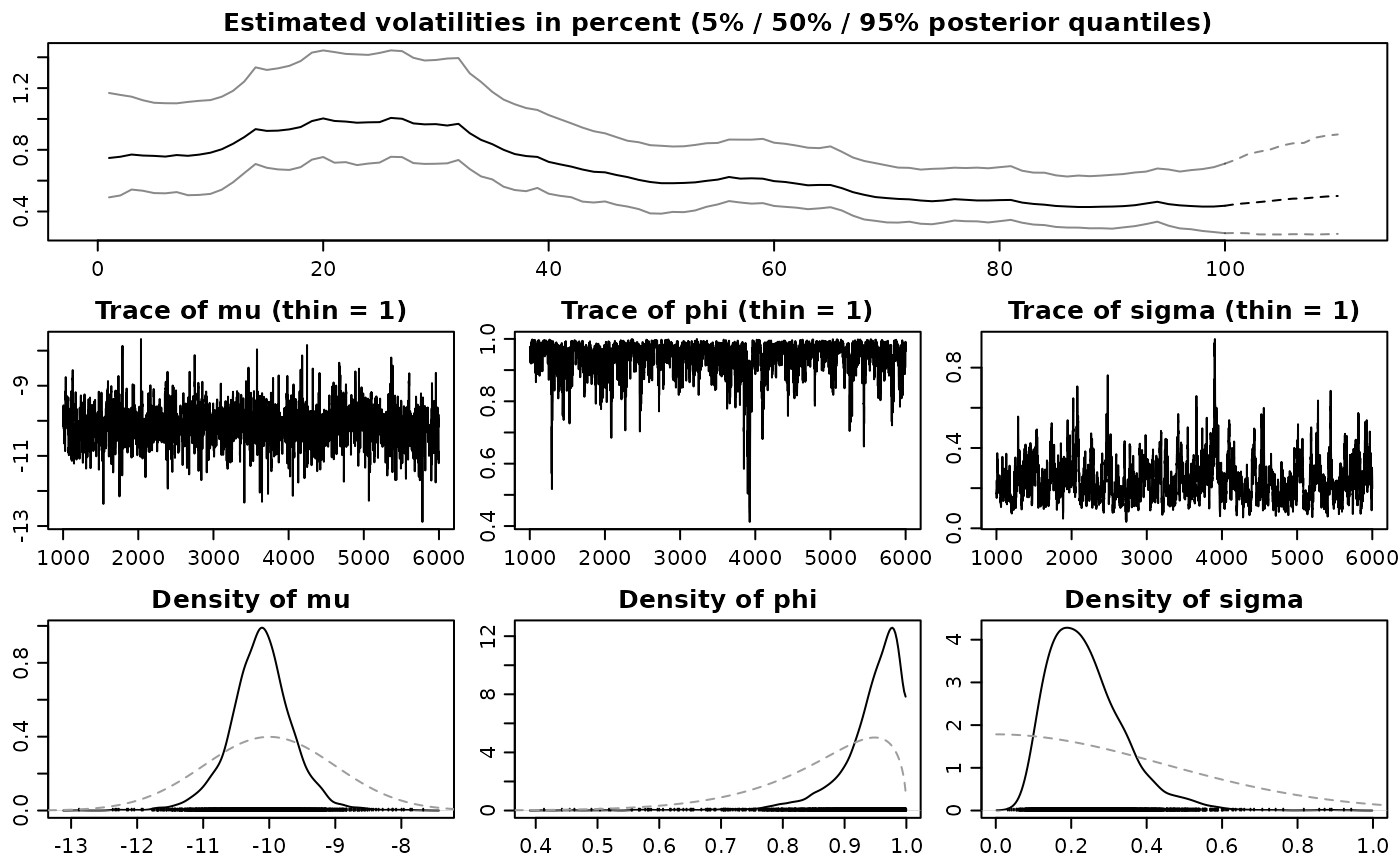plot.svdraws and plot.svldraws generate some plots visualizing the posterior
distribution and can also be used to display predictive distributions of
future volatilities.
Arguments
- x
svdrawsobject.- forecast
nonnegative integer or object of class
svpredict, as returned bypredict.svdraws. If an integer greater than 0 is provided,predict.svdrawsis invoked to obtain theforecast-step-ahead prediction. The default value is0.- dates
vector of length
ncol(x$latent), providing optional dates for labelling the x-axis. The default value isNULL; in this case, the axis will be labelled with numbers.- show0
logical value, indicating whether the initial volatility
exp(h_0/2)should be displayed. The default value isFALSE. Only available for inputsxof classsvdraws.- showobs
logical value, indicating whether the observations should be displayed along the x-axis. If many draws have been obtained, the default (
TRUE) can render the plotting to be quite slow, and you might want to try settingshowobstoFALSE.- showprior
logical value, indicating whether the prior distribution should be displayed. The default value is
TRUE.- forecastlty
vector of line type values (see
par) used for plotting quantiles of predictive distributions. The default valueNULLresults in dashed lines.- tcl
The length of tick marks as a fraction of the height of a line of text. See
parfor details. The default value is-0.4, which results in slightly shorter tick marks than usual.- mar
numerical vector of length 4, indicating the plot margins. See
parfor details. The default value isc(1.9, 1.9, 1.9, 0.5), which is slightly smaller than the R-defaults.- mgp
numerical vector of length 3, indicating the axis and label positions. See
parfor details. The default value isc(2, 0.6, 0), which is slightly smaller than the R-defaults.- simobj
object of class
svsimas returned by the SV simulation functionsvsim. If provided, the “true” data generating values will be added to the plots.- newdata
corresponds to parameter
newdatainpredict.svdraws. Only ifforecastis a positive integer andpredict.svdrawsneeds anewdataobject. Corresponds to input parameterdesignmatrixinsvsample. A matrix of regressors with number of rows equal to parameterforecast.- ...
further arguments are passed on to the invoked plotting functions.
Value
Called for its side effects. Returns argument x invisibly.
Details
These functions set up the page layout and call volplot,
paratraceplot and paradensplot.
Note
In case you want different quantiles to be plotted, use
updatesummary on the svdraws object first. An example
of doing so is given in the Examples section.
See also
updatesummary, predict.svdraws
Other plotting:
paradensplot(),
paratraceplot(),
paratraceplot.svdraws(),
plot.svpredict(),
volplot()
Examples
## Simulate a short and highly persistent SV process
sim <- svsim(100, mu = -10, phi = 0.99, sigma = 0.2)
## Obtain 5000 draws from the sampler (that's not a lot)
draws <- svsample(sim$y, draws = 5000, burnin = 1000,
priormu = c(-10, 1), priorphi = c(20, 1.5), priorsigma = 0.2)
#> Done!
#> Summarizing posterior draws...
## Plot the latent volatilities and some forecasts
plot(draws, forecast = 10)
 ## Re-plot with different quantiles
newquants <- c(0.01, 0.05, 0.25, 0.5, 0.75, 0.95, 0.99)
draws <- updatesummary(draws, quantiles = newquants)
plot(draws, forecast = 20, showobs = FALSE,
forecastlty = 3, showprior = FALSE)
## Re-plot with different quantiles
newquants <- c(0.01, 0.05, 0.25, 0.5, 0.75, 0.95, 0.99)
draws <- updatesummary(draws, quantiles = newquants)
plot(draws, forecast = 20, showobs = FALSE,
forecastlty = 3, showprior = FALSE)
